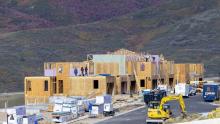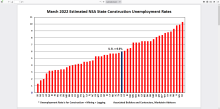
Thirty-two states had lower unemployment rates over the same period, Iowa and Missouri were unchanged, and 16 were higher.
National NSA payroll construction employment was 242,000 higher than in December 2021. From March through December 2022, seasonally adjusted construction employment was above its February 2020 pre-pandemic peak of 7,624,000, except for a slight dip in April.

As of December, it was 153,000 greater than its pre-pandemic peak.
Residential construction employment has fully recovered, while nonresidential construction employment is still below its pre-pandemic peak. December SA residential payroll construction employment was 198,000 above its pre-pandemic peak, while nonresidential payroll construction employment was 45,000 below its pre-pandemic peak.
In December 2022, 36 states had lower construction unemployment rates, and 14 states had higher rates compared to December 2019.
“High-interest rates are negatively affecting demand for single-family housing, yet construction employment continues to rise as builders work on their backlog of projects,” said Bernard Markstein, president and chief economist of Markstein Advisors, who conducted the analyses for ABC. “However, developers, builders and contractors are still facing a shortage of skilled workers. So far, construction employers are holding on to their workers as they look beyond the current slowing construction demand to the eventual upturn in demand for new projects. Meanwhile, nonresidential construction employers fully expect demand to rise over this year and next as more state and local projects tap into federal funds from the Infrastructure Investment and Jobs Act and move from the planning stage to the execution stage.”
National and state unemployment rates are best evaluated on a year-over-year basis because these industry-specific rates are not seasonally adjusted. However, due to the changing impact of COVID-19, high and rising interest rates and other national and international disruptions, month-to-month comparisons offer insight into the rapidly shifting economic environment for construction employment.
In December 2022, nine states had lower estimated construction unemployment rates than in November, 38 states had higher rates, and three (Georgia, Indiana and Tennessee) had the same rate.
The five states with the lowest December 2022 estimated NSA construction unemployment rates were:
- Colorado, 1.2%
- Tennessee, 2%
- Utah, 2.1%
- Florida, 2.2%
- Nebraska, 2.6%
Except for Utah, all these states posted their lowest estimated December NSA construction unemployment rate on record. Utah had its third lowest rate, behind 2021’s 1.7% and 2015’s 2%.
The states with the highest December 2022 estimated NSA construction unemployment rates were:
- Illinois, 7.1%
- Ohio, 7.4%
- Minnesota, 7.6%
- Wyoming, 10.4%
- Alaska, 13.3%
Alaska had its second lowest December estimated construction unemployment rate behind the 2020s 11.8% rate and the third largest year-over-year decline in its rate among the states (tied with Pennsylvania), behind Rhode Island and Hawaii, down 2.3% from December 2021. The other four states each had their third-lowest December unemployment rate on record.
To better understand the basis for calculating unemployment rates and what they measure, check out the Background on State Construction Unemployment Rates.










